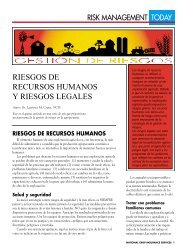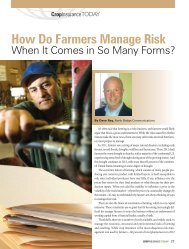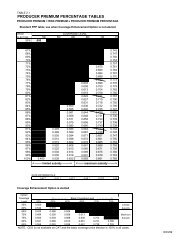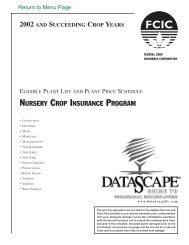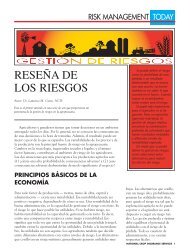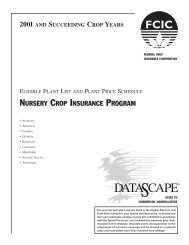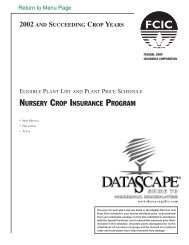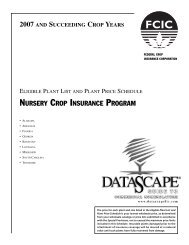The PRISM Climate and Weather System - National Crop Insurance ...
The PRISM Climate and Weather System - National Crop Insurance ...
The PRISM Climate and Weather System - National Crop Insurance ...
You also want an ePaper? Increase the reach of your titles
YUMPU automatically turns print PDFs into web optimized ePapers that Google loves.
<strong>Crop</strong><strong>Insurance</strong> TODAY<br />
<strong>The</strong> <strong>PRISM</strong> <strong>Climate</strong><br />
<strong>and</strong> <strong>Weather</strong> <strong>System</strong><br />
An Introduction<br />
By Christopher Daly, Oregon State University <strong>and</strong> Kirk Bryant, Risk Management Agency<br />
<strong>Weather</strong> <strong>and</strong> climate are arguably the most<br />
powerful drivers of both agricultural <strong>and</strong> natural<br />
systems, <strong>and</strong> have profound effects on<br />
how our society functions. <strong>Weather</strong> is what<br />
we experience day to day, while climate is a<br />
longer-term summary of expected weather<br />
conditions. In other words, climate is what<br />
you expect, <strong>and</strong> weather is what you get. Both<br />
are important in determining what crops can<br />
be grown successfully, what plants will thrive<br />
in your garden, how roads <strong>and</strong> buildings are<br />
constructed, <strong>and</strong> even the clothes you wear.<br />
With the advent of computer-based geographic<br />
information systems (GIS), global<br />
positioning systems, <strong>and</strong> remote sensing<br />
technologies that help us describe <strong>and</strong> visualize<br />
the earth’s surface, many planning <strong>and</strong><br />
decision-making activities have gone spatial.<br />
A wide variety of agricultural, hydrologic,<br />
ecological, natural resource, <strong>and</strong> economic<br />
decision support tools are now linked to these<br />
technologies in new <strong>and</strong> exciting ways.<br />
Spatial decision support tools have an<br />
insatiable thirst for spatial data sets. Spatial<br />
weather <strong>and</strong> climate data, usually in the form<br />
of continuous grids of pixels, are often key<br />
inputs to these tools, <strong>and</strong> form the basis for<br />
scientific conclusions, management decisions,<br />
<strong>and</strong> other important outcomes. <strong>The</strong>se grids<br />
typically describe minimum <strong>and</strong> maximum<br />
temperature <strong>and</strong> precipitation over a monthly<br />
or daily time step, <strong>and</strong> are especially useful<br />
because they provide wall-to-wall estimates<br />
of climate conditions, even where no weather<br />
stations exist.<br />
<strong>The</strong> most widely used spatial climate data<br />
sets in the United States are those developed<br />
by Oregon State University’s <strong>PRISM</strong> <strong>Climate</strong><br />
4 AUGUST2013<br />
Group, named for the <strong>PRISM</strong> climate mapping<br />
system. <strong>PRISM</strong> products are the official<br />
spatial climate data sets of the USDA, <strong>and</strong> are<br />
used by thous<strong>and</strong>s of agencies, universities,<br />
<strong>and</strong> companies worldwide. Now, <strong>PRISM</strong> is<br />
being put to work to improve the efficiency<br />
<strong>and</strong> integrity of the U.S. crop insurance program.<br />
In this article, we introduce you to the<br />
history of climate mapping, how the <strong>PRISM</strong><br />
weather <strong>and</strong> climate mapping system was developed,<br />
<strong>and</strong> how it works. In a subsequent<br />
article, we will explain how <strong>PRISM</strong> is being<br />
used in crop insurance.<br />
A Little History<br />
Beginning in the early 20th century, official,<br />
30-year average climate maps within<br />
the U.S. (most done by state), were created<br />
by expert climatologists with pen <strong>and</strong> paper.<br />
Observations from weather stations were<br />
plotted on a map, <strong>and</strong> generalized contours of<br />
temperature <strong>and</strong> precipitation drawn between<br />
the stations, based on the subjective opinion<br />
of the analyst. <strong>The</strong> process was tedious <strong>and</strong><br />
time-consuming. It is not surprising that these<br />
maps were updated infrequently throughout<br />
the 20th century.<br />
Figure 1. Precipitation: Annual Climatology (1981-2010)<br />
<strong>PRISM</strong> map of mean annual precipitation, averaged over the years 1981-2010. Thirty years<br />
is considered the st<strong>and</strong>ard averaging period for describing the long-term climate of a<br />
region. <strong>The</strong> period typically moves forward once per decade (the next official period will be<br />
1991-2020). This map is made up of over 20 million grid cells, each about ½-mile on a side.
By the early 1990s, the most recent official<br />
precipitation maps for many states were thirty<br />
years out of date. GIS was gaining rapid acceptance,<br />
<strong>and</strong> the dem<strong>and</strong> for digital climate<br />
maps was growing rapidly. Computerized statistical<br />
algorithms that interpolate values between<br />
point observations had become available,<br />
but these were generalized functions<br />
that were “climate challenged.” <strong>The</strong>y produced<br />
unrealistic maps because they lacked information<br />
on how the physiographic features<br />
of the earth’s surface (such as mountains <strong>and</strong><br />
coastlines) affected climatic patterns. In other<br />
words, there was a wide divide between what<br />
we knew about climate patterns <strong>and</strong> what<br />
computerized tools could produce. <strong>The</strong> timing<br />
was right for a new method of creating climate<br />
maps that would bring some intelligence<br />
to the process.<br />
<strong>The</strong> Advent of <strong>PRISM</strong><br />
A new approach to computerized climate<br />
mapping was first developed by Chris Daly in<br />
1991 when he was a Ph.D. student at Oregon<br />
State University. <strong>The</strong> algorithm was written to<br />
mimic the thought process an expert climatologist<br />
goes through while drawing a climate<br />
map. This kind of a program is called an “expert<br />
system” in computer science circles.<br />
Precipitation was the most difficult variable<br />
map, so he started there. He knew that elevation<br />
was the main determinant of precipitation<br />
patterns. In fact, many h<strong>and</strong>-drawn maps were<br />
sketched onto topographic maps, because the<br />
contours of elevation <strong>and</strong> precipitation had<br />
such similar patterns. <strong>The</strong> initial program he<br />
developed “visited” each pixel on an elevation<br />
grid <strong>and</strong> developed a local statistical relationship<br />
for that pixel, called a regression function,<br />
between precipitation <strong>and</strong> elevation, using<br />
data from stations in the immediate vicinity.<br />
<strong>The</strong> regression function was used to predict<br />
precipitation at the elevation of the pixel.<br />
It turned out that the relationship between<br />
precipitation <strong>and</strong> elevation varied a lot across<br />
the l<strong>and</strong>scape, sometimes quite sharply, as in<br />
the case of rain shadows. An algorithm was<br />
written to automatically divide the terrain<br />
into “topographic facets” with several slope<br />
orientation categories (hill slopes facing W,<br />
NW, N, NE, etc.). Available weather stations<br />
were grouped onto these facets, <strong>and</strong> the precipitation-elevation<br />
regression function calculated<br />
for stations on each facet separately.<br />
In this way, his model did not mix stations on<br />
Figure 2. Oregon Annual Precipitation<br />
Close up of a <strong>PRISM</strong> mean annual precipitation map for northwestern Oregon. Cool colors<br />
denote wet regions <strong>and</strong> warm colors denote dry regions. <strong>The</strong> Coast Range <strong>and</strong> Cascade<br />
Range both act to increase precipitation on their windward slopes, effectively ‘wringing out”<br />
moisture moving inl<strong>and</strong> off the Pacific Ocean, <strong>and</strong> leaving relatively little on their leeward<br />
slopes. East of the Cascades, only about 10 percent of the original moisture is left.<br />
windward <strong>and</strong> leeward slopes of mountain<br />
ranges, which, even at the same elevation, had<br />
very different precipitation amounts. Little by<br />
little, other enhancements were made, until<br />
the program could recognize <strong>and</strong> troubleshoot<br />
problems as they arose, like an expert<br />
climatologist might do. This expert system<br />
was called <strong>PRISM</strong> (Parameter-elevation Regressions<br />
on Independent Slopes Model).<br />
Shortly after the development of the initial<br />
version of <strong>PRISM</strong>, the USDA Natural<br />
Resources Conservation Service (NRCS) became<br />
interested in this work, because they<br />
were implementing GIS in their field offices<br />
<strong>and</strong> had a great need for updated, digital, precipitation<br />
maps. <strong>The</strong> NRCS offered to provide<br />
funding for the development of proof-of-concept<br />
<strong>PRISM</strong> precipitation maps for Oregon,<br />
Idaho, Nevada, <strong>and</strong> Utah. <strong>The</strong>se were some of<br />
the most complex states to map, with snowy<br />
mountains, alkali deserts, <strong>and</strong> everything<br />
in-between. <strong>The</strong> State Climatologists from<br />
these states were asked to scrutinized the<br />
results, compare them with their own h<strong>and</strong>drawn<br />
maps, <strong>and</strong> offer suggestions for improvements.<br />
At the end of two years of scrutiny,<br />
criticism, <strong>and</strong> re-dos, they finally agreed<br />
that <strong>PRISM</strong> had produced precipitation maps<br />
that equaled or exceeded the quality of their<br />
own maps. This led to a multi-year NRCS<br />
program to map 1961-90 averages of both<br />
temperature <strong>and</strong> precipitation over all of the<br />
lower 48 states. Daly began to collect a team of<br />
talented scientists <strong>and</strong> programmers around<br />
him, which would become the <strong>PRISM</strong> <strong>Climate</strong><br />
Group. <strong>The</strong> success of the NRCS project<br />
opened the door to many other climate mapping<br />
projects, some outside the US, including<br />
Canada, China, Mongolia, Taiwan, SE Asia,<br />
<strong>and</strong> Europe. Funding came from a wide variety<br />
of sources, including many agencies within<br />
the USDA <strong>and</strong> NOAA, NASA, NPS, USFS,<br />
USEPA, NSF, <strong>The</strong> Nature Conservancy, <strong>and</strong><br />
others. <strong>The</strong>se analyses <strong>and</strong> data sets underwent<br />
an unprecedented level of peer review,<br />
sometimes involving dozens of reviewers.<br />
Each map product represented the state of the<br />
science for that area.<br />
In the years since its inception, <strong>PRISM</strong> has<br />
undergone nearly constant development, <strong>and</strong><br />
is now a large, mature model. Some things<br />
have remained essentially the same; <strong>PRISM</strong><br />
still adopts the assumption that for a localized<br />
region, elevation is the most important<br />
factor in the distribution of climate variables.<br />
<strong>PRISM</strong> still calculates a local climate-elevation<br />
relationship for each grid cell, whether it<br />
be for precipitation, temperature, dew point,<br />
<strong>Crop</strong><strong>Insurance</strong> TODAY ® 5
Figure 3. January 1971-2000 Minimum Temperature in the<br />
Gunnison, Colorado area.<br />
Oblique view (looking from south to north) of <strong>PRISM</strong> January 1971-2000 mean minimum<br />
temperature in the Gunnison, Colorado area. Complex relationships between elevation<br />
<strong>and</strong> temperature are due to cold air pooling in valley bottoms (purple colors) <strong>and</strong> warmer<br />
“banana belts” at mid-slope locations above the cold air pools (green <strong>and</strong> yellow colors).<br />
Temperatures become colder again on the highest peaks.<br />
or other variables, <strong>and</strong> uses nearby station<br />
data to populate the regression function.<br />
What has changed is that when <strong>PRISM</strong> does<br />
its climate-elevation regression calculations,<br />
it now weights the station data points to control<br />
for the effects of a wide variety of physiographic<br />
variables. In addition to topographic<br />
facets, <strong>PRISM</strong> now has station weighting<br />
functions that account for proximity to coastlines,<br />
the location of temperature inversions<br />
<strong>and</strong> cold air pools, <strong>and</strong> several measures of<br />
terrain complexity.<br />
Figure 4. Annual Precipitation, 1895-2012: Texas County, Okla.<br />
<strong>PRISM</strong> one-hundred eighteen-year time series of annual precipitation for a grid cell in Texas<br />
County, western Oklahoma, derived from <strong>PRISM</strong> time series grids for the conterminous<br />
United States. Multi-year droughts in the 1930s, 1950s, <strong>and</strong> 2011-2012 are clearly visible.<br />
Time Series Mapping <strong>and</strong><br />
the <strong>Climate</strong> Fingerprint<br />
So far, we have been learning about how<br />
<strong>PRISM</strong> creates long-term climate maps, such<br />
as mean monthly <strong>and</strong> annual precipitation<br />
over a thirty-year period (for example, 1961-<br />
1990, 1971-2000, etc.). But there is more<br />
to climate than long-term averages. Users<br />
wanted to know: how variable is the climate?<br />
When were the droughts <strong>and</strong> heat waves <strong>and</strong><br />
how severe were they? <strong>The</strong> next logical step<br />
was to create a time series of grids where each<br />
grid represented one month in one year, not<br />
a 30-year average month. <strong>PRISM</strong>’s first foray<br />
into time series mapping was supported by<br />
NOAA in the late 1990s, <strong>and</strong> was quite ambitious:<br />
create a 100-year time series of monthly<br />
grids, starting in 1895. <strong>The</strong> problem was that<br />
there were few weather stations in 1895, <strong>and</strong><br />
it was unlikely a map for 1895 would have the<br />
same accuracy <strong>and</strong> detail as one produced using<br />
data from, say, 1995. This eventually led<br />
to a new interpolation technique that did not<br />
rely directly on elevation, but instead relied<br />
on what is termed the “climate fingerprint.”<br />
<strong>The</strong> idea behind the climate fingerprint is that<br />
patterns in climate caused by the earth’s physiography<br />
tend to be repeatable over time. For<br />
example, a location that is in a rain shadow today<br />
most likely behaved in a similar way 100<br />
years ago. To implement climate fingerprint<br />
interpolation, the elevation grid normally<br />
used in the <strong>PRISM</strong> regression calculations<br />
was replaced with long-term climate maps,<br />
e.g., 1971-2000 averages, which already had<br />
the effects of physiographic features built in.<br />
<strong>The</strong> method allowed the creation of climate<br />
maps of similar detail, no matter what the year<br />
or density of weather stations, because the<br />
long-term climate patterns took over where<br />
there were no stations.<br />
Going to the next level for<br />
<strong>Crop</strong> <strong>Insurance</strong><br />
When the USDA Risk Management Agency<br />
asked the <strong>PRISM</strong> <strong>Climate</strong> Group to help<br />
improve their climate <strong>and</strong> weather data for<br />
crop insurance needs, it was clear even more<br />
detailed data over a variety of time periods<br />
would be needed, from long-term average climate<br />
to daily weather. In the next article, we<br />
will tell you about the development of <strong>PRISM</strong><br />
data for crop insurance, <strong>and</strong> an innovative<br />
web portal that allows users to access this information<br />
in simple <strong>and</strong> intuitive ways.<br />
6 AUGUST2013



